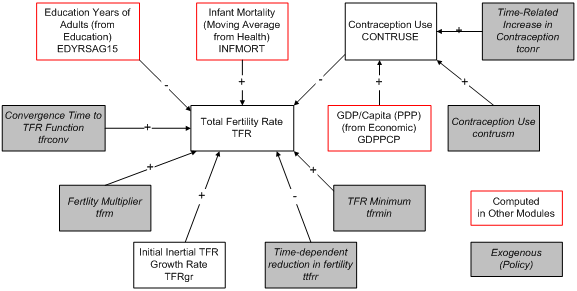International Futures Help System
Fertility Detail
The central indicator of fertility is the total fertility rate (TFR), the number of children that the average woman will bear throughout her life. Fertility generally decreases in the long run as deep or distal drivers such as GDP per capita (from the economic model) or formal years of education of adults (EDYRSAG15 from the education model) increase; our own analysis suggested the use of education years, a result that Angeles (2010) reinforced.
In addition there are more proximate drivers, some of which can change more rapidly than GDP per capita or education levels and thereby affect fertility rate. We represent two, namely infant mortality rates (INFMOR) and contraception usage (CONTRUSE). The health model of IFs determines infant mortality rates. Sudden change in those do not, however, immediately affect fertility rates and we smooth changes in rates so as to introduce an approximately 10-year lag, consistent again with the findings of Angeles (2010). Based on cross-sectional analysis the population model of IFs forecasts the percentage of population using modern contraception as a function of GDP per capita at purchasing power parity (GDPPCP). We found, however, that there was additional growth over time and the parameter for time-related usage growth ( tconr ) controls that. The user can also change contraception use via an exogenous multiplier ( contrusm ).
Although those three distal and proximate drivers substantially determine the forecasts of fertility rate, there are several additional elements that influence it. First, we calculate the historical growth rate of TFR (TFRgr) and use that internal variable in the first few years so as to maintain an inertial pattern of change in TFR consistent with history; we phase out that inertial element in favor of endogenously computed factors over a 10-year period. Second, we have used another time dependent parameter ( ttfrr ) to allow introduction of somewhat faster or slower growth rates in TFR. Mostly we have used that as a tuning parameter to adjust our long-term global population forecasts to be more consistent with those of others such as the UN Population Division or the International Institute of Applied Systems Analysis. Normally that parameter is very small or zero. Third, we provide the user with a direct multiplier on the fertility rate ( tfrm ). And finally, not knowing what the long-term minimum fertility rate might be in a world where for many countries rates have fallen very substantially below replacement rates, we provide such a minimum ( tfrmin ). Since some countries are below most expected minimums and therefore below common values of that parameter, we phase that minimum in over time with a convergence parameter ( tfrconv ), which serves double duty by also marking the number of years of convergence of TFR itself to the values that the function with distal and proximate drivers produces.

 International Futures at the Pardee Center
International Futures at the Pardee Center